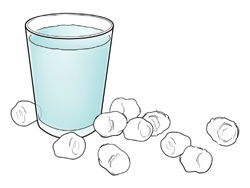Experiment: Cool Cotton
You can’t cook ’em. You can’t eat ’em. So why are so many farms dedicated to raising these fluffy white balls? God clearly had people in mind when He designed this lowly plant with so many desirable qualities.
Unless you were to turn your car off the interstate that runs down the spine of southern Alabama, jostle over red dirt roads, and pass a pecan stand or two, you’d probably never see the fields of white tufts bursting out of dry brown plants. But they’re there, shimmering through the waves of August heat in rows as far as the eye can see. Here, off the main thoroughfares is an unappetizing crop whose value is easily overlooked. In fact, this plant and its fruit, cotton, are woven into just about every corner of our lives.
These little white tufts (or bolls) of cotton show how bountiful God’s creation really is. You can see so for yourself. Just look at the tag on a pair of jeans, towel, shirt, sheets, handkerchief, or pretty much any piece of clothing you own. For the most part, you’ll find at least some percentage of cotton woven into the threads. You’re surrounded.
Cotton gets spun into more than just clothes and other household materials. The oil from crushed seeds makes its way into salad dressing, mayonnaise, and cake icing (gives a whole new meaning to the phrase “cotton mouth”). Even the linters are useful—the short, silky fuzz that clings to the cottonseeds after the boll has been stripped away. Manufacturers use them to make plastics and high-quality paper.
But it’s not just a modern marvel. If you dig back into history, you’ll find that cotton crops up through the millennia. Not long after the Flood, people as far afield as India, Egypt, and Mexico spun the fibers into necklaces and clothing. Megasthenes (ca. 350–290 BC), a Greek historian who lived around the time of Alexander the Great (356–323 BC), told a yarn about the “trees that grow wool” he’d witnessed in Southeast Asia. (Such stories caused some Europeans to imagine the plants had tiny sheep growing out of them.)
One of its drawbacks was the intensive labor required to separate the cotton. But with the invention of machines that could pull the seeds from the cotton bolls (such as the cotton gin in the late 1700s), production costs dropped and cotton boomed globally. Even today, about 2.5% of all the farmable land in the world is dedicated to these little white tufts, and those farms yield some 25 million tons of produce.1 (That’s one big cotton ball.)
God clearly had us in mind when He designed this unique plant. With such amazing properties, it’s no wonder your house abounds with this downy fabric. Those power-packed puffs are almost pure cellulose, the durable organic compound that makes up plant cell walls. That means cotton is both strong and quickly replenishable (about 200 days from planting to harvesting). A single 500-pound (227 kg) bale of cotton can be stretched to produce 215 pairs of jeans, 250 single bed sheets, 4,300 pairs of socks, 1,200 T-shirts, 2,100 pairs of shorts, or 680,000 cotton balls.2
Cotton is not like leather or many other heavy types of clothing material. The loosely packed fibers in cotton make for a breathable, hypoallergenic fabric that doesn’t make you simmer in summer. But the same fabric, when layered, serves well in wintertime, as good as any blanket, because it is such a good heat preserver. (You could say it’s God’s two-for-one clothing material.)
If you’re not impressed yet, then soak in this: a cotton towel can soak up nearly 27 times its own weight in water. Once engorged with the H20, the fiber becomes even stronger. Why? Because the hydrogen atoms in the water bond with the cellulose and other water molecules, making for one tough conglomeration.
Frankly, there’s no other natural fiber quite like cotton. When you look in your closet for cotton creations, you’ll probably discover a myriad of colors. That’s because the fibers superbly soak up dyes and hold in the hues for a long time. Better still for busy parents, cotton cleans up with relative ease after a simple trip through the washer. Unlike some synthetic materials, you won’t have to take it to the drycleaners.
So, while you may never have journeyed off the main road to see these rural fields, you can rest assured that someone is still growing lots of the white puffy material that blesses pretty much every aspect of your life. Cotton just goes to show you that God’s handiwork never fails to wow—and that’s no spin.
See For Yourself . . .
Cotton feels fluffy because there’s a great deal of empty space in there. That’s one reason it’s so cool to wear. You probably never realized just how much empty space there is, but you’ll see a hint of that in this experiment. Note: Make sure you get your parents’ permission to plunder their cotton ball collection, and you should do this experiment on a water-resistant surface or outside.
What You’ll Need

A bag of large cotton balls
A small glass
Water
A towel to dry up any spills
(a cotton towel, of course)
What You’ll Do
- Fill your glass with water to about 1/4 inch (0.5 centimeter) from the top.
- Make your best guess of how many cotton balls you can fit into the glass before the water overflows. Write it down.
- Drop in a few cotton balls.
- Write down what happened.
- Now put in as many cotton balls as will fit. Gently press them down with your fingers, without spilling, if you need to make more room.
- Let the cotton balls dry, and you can reuse them. (They might be a bit deformed, but they’ll still work.)
Reflect
Were you surprised by how many cotton balls could fit in the glass?
How could this property of cotton be useful around the house or in other situations?
Answers Magazine
October – December 2013
With an updated interior design, the fall issue has it all, from breaking down the big bang to building a better understanding of dinosaurs, from public schools to pinnipeds, and from archaeological discoveries at Çatalhöyük to the astronomical delight of a Christmas comet.
Browse IssueFootnotes
- http://www.naturalfibres2009.org/en/fibres/cotton.html
- http://cottonaustralia.com.au/cotton-library/fact-sheets/cotton-fact-file-cotton-properties-and-products
Recommended Resources

Answers in Genesis is an apologetics ministry, dedicated to helping Christians defend their faith and proclaim the good news of Jesus Christ.
- Customer Service 800.778.3390
- Available Monday–Friday | 9 AM–5 PM ET
- © 2025 Answers in Genesis





